Laser Transverse Modes with Ray-Wave Duality: A Review
Abstract
:1. Introduction
2. Ideal Spherical Cavity
2.1. Eigenfrequency Spectrum
2.2. Parametric Equations for Geometric Rays
2.3. Wave Representation for Unifying the Eigenmodes and Geometric Modes
2.4. Experimental Results and Theoretical Confirmations
3. Spherical Cavity with Astigmatism
3.1. Eigenfrequency Spectrum and Lissajous Geometric Modes
3.2. Parametric Equations for Lissajous Geometric Rays
3.3. Wave Representation for Lissajous Geometric Modes
3.4. Experimental and Numerical Results
4. Damping Effect
5. Conclusions
Author Contributions
Funding
Institutional Review Board Statement
Informed Consent Statement
Data Availability Statement
Conflicts of Interest
References
- Haus, H.A. Waves and Fields in Optoelectronics; Prentice-Hall: Englewood Cliffs, NJ, USA, 1984. [Google Scholar]
- Chen, Y.F.; Lee, C.C.; Wang, C.H.; Hsieh, M.X. Laser transverse modes of spherical resonators: A review [Invited]. Chin. Opt. Lett. 2020, 18, 091404. [Google Scholar] [CrossRef]
- Boyd, G.D.; Kogelnik, H. Generalized Confocal Resonator Theory. Bell Syst. Tech. J. 1962, 41, 1347–1369. [Google Scholar] [CrossRef]
- Chen, Y.F.; Huang, T.M.; Kao, C.F.; Wang, C.L.; Wang, S.C. Generation of Hermite-Gaussian modes in fiber-coupled la–ser-diode end-pumped lasers. IEEE J. Quantum Electron. 1997, 33, 1025–1031. [Google Scholar] [CrossRef]
- Laabs, H.; Ozygus, B. Excitation of Hermite Gaussian modes in end-pumped solid-state lasers via off-axis pumping. Opt. Laser Technol. 1996, 28, 213–214. [Google Scholar] [CrossRef]
- Chen, Y.F.; Chang, C.C.; Lee, C.Y.; Tung, J.C.; Liang, H.C.; Huang, K.F. Characterizing the propagation evolution of wave patterns and vortex structures in astigmatic transformations of Hermite–Gaussian beams. Laser Phys. 2017, 28, 015002. [Google Scholar] [CrossRef]
- Chen, Y.F.; Lan, Y.P. Dynamics of the Laguerre Gaussian TEM*0,l mode in a solid-state laser. Phys. Rev. A 2001, 63, 063807. [Google Scholar] [CrossRef]
- Flood, C.J.; Giuliani, G.; Van Driel, H.M. Preferential operation of an end-pumped Nd:YAG laser in high-order Laguerre–Gauss modes. Opt. Lett. 1990, 15, 215–217. [Google Scholar] [CrossRef] [PubMed]
- Bisson, J.-F.; Senatsky, Y.; Ueda, K.-I. Generation of Laguerre-Gaussian modes in Nd:YAG laser using diffractive optical pumping. Laser Phys. Lett. 2005, 2, 327–333. [Google Scholar] [CrossRef]
- Kim, J.; Clarkson, W.A. Selective generation of Laguerre–Gaussian (LG0n) mode output in a diode-laser pumped Nd:YAG laser. Opt. Commun. 2013, 296, 109–112. [Google Scholar] [CrossRef]
- Lee, A.J.; Omatsu, T.; Pask, H.M. Direct generation of a first-Stokes vortex laser beam from a self-Raman laser. Opt. Express 2013, 21, 12401–12409. [Google Scholar] [CrossRef]
- Dingjan, J.; van Exter, M.; Woerdman, J. Geometric modes in a single-frequency Nd:YVO4 laser. Opt. Commun. 2001, 188, 345–351. [Google Scholar] [CrossRef]
- Chen, Y.F.; Jiang, C.H.; Lan, Y.P.; Huang, K.F. Wave representation of geometrical laser beam trajectories in a hemiconfocal cavity. Phys. Rev. A 2004, 69, 053807. [Google Scholar] [CrossRef]
- Chen, Y.F.; Tung, J.C.; Chiang, P.Y.; Liang, H.C.; Huang, K.F. Exploring the effect of fractional degeneracy and the emer–gence of ray-wave duality in solid-state lasers with off-axis pumping. Phys. Rev. A 2013, 88, 013827. [Google Scholar] [CrossRef] [Green Version]
- Tung, J.C.; Liang, H.C.; Tuan, P.H.; Chang, F.L.; Huang, K.F.; Lu, T.H.; Chen, Y.F. Selective pumping and spatial hole burning for generation of photon wave packets with ray-wave duality in solid-state lasers. Laser Phys. Lett. 2016, 13. [Google Scholar] [CrossRef]
- Chen, Y.F.; Chang, C.C.; Lee, C.Y.; Sung, C.L.; Tung, J.C.; Su, K.W.; Liang, H.C.; Chen, W.D.; Zhang, G. High-peak-power large-angular-momentum beams generated from passively Q-switched geometric modes with astigmatic transformation. Photonics Res. 2017, 5, 561–566. [Google Scholar] [CrossRef]
- Barré, N.; Romanelli, M.; Lebental, M.; Brunel, M. Waves and rays in plano-concave laser cavities: I. Geometric modes in the paraxial approximation. Eur. J. Phys. 2017, 38, 034010. [Google Scholar] [CrossRef]
- Chen, Y.F.; Li, S.C.; Hsieh, Y.H.; Tung, J.C.; Liang, H.C.; Huang, K.F. Laser wave-packet representation to unify eigenmodes and geometric modes in spherical cavities. Opt. Lett. 2019, 44, 2649–2652. [Google Scholar] [CrossRef]
- Tung, J.C.; Hsieh, Y.H.; Omatsu, T.; Huang, K.F.; Chen, Y.F. Generating laser transverse modes analogous to quantum Green’s functions of two-dimensional harmonic oscillators. Photon–Res. 2017, 5, 733. [Google Scholar] [CrossRef]
- Chen, Y.F.; Tung, J.C.; Tuan, P.H.; Yu, Y.T.; Liang, H.C.; Huang, K.F. Characterizing classical periodic orbits from quantum Green’s functions in two-dimensional integrable systems: Harmonic oscillators and quantum billiards. Phys. Rev. E 2017, 95, 012217. [Google Scholar] [CrossRef] [Green Version]
- Chen, Y.-F.; Tseng, Y.C.; Ke, H.T.; Hsieh, M.X.; Tung, J.-C.; Hsieh, Y.H.; Liang, H.-C.; Huang, K.F. High-power structured laser modes: Manifestation of quantum Green’s function. Opt. Lett. 2020, 45, 4579. [Google Scholar] [CrossRef]
- Keski-Rahkonen, J.; Ruhanen, A.; Heller, E.J.; Räsänen, E. Quantum Lissajous Scars. Phys. Rev. Lett. 2019, 123, 214101. [Google Scholar] [CrossRef] [PubMed] [Green Version]
- Huang, K.F.; Chen, Y.F.; Lai, H.C.; Lan, Y.P. Observation of the Wave Function of a Quantum Billiard from the Transverse Patterns of Vertical Cavity Surface Emitting Lasers. Phys. Rev. Lett. 2002, 89, 224102. [Google Scholar] [CrossRef] [PubMed]
- Chen, C.C.; Liu, C.C.; Su, K.W.; Lu, T.H.; Chen, Y.F.; Huang, K.F. Statistical properties of experimental coherent waves in microcavity lasers: Analogous study of quantum billiard wave functions. Phys. Rev. E 2007, 75, 046202. [Google Scholar] [CrossRef] [Green Version]
- Chen, C.C.; Yu, Y.T.; Chen, R.C.C.; Huang, Y.J.; Su, K.W.; Chen, Y.F.; Huang, K.F. Transient Dynamics of Coherent Waves Released from Quantum Billiards and Analogous Observation from Free-Space Propagation of Laser Modes. Phys. Rev. Lett. 2009, 102, 044101. [Google Scholar] [CrossRef] [Green Version]
- Chen, Y.F.; Yu, Y.T.; Chiang, P.Y.; Tuan, P.H.; Huang, Y.J.; Liang, H.C.; Huang, K.F. Manifestation of quantum-billiard eigenvalue statistics from subthreshold emission of vertical-cavity surface-emitting lasers. Phys. Rev. E 2011, 83, 016208. [Google Scholar] [CrossRef] [Green Version]
- Yu, Y.T.; Tuan, P.H.; Chang, K.C.; Hsieh, Y.H.; Huang, K.F.; Chen, Y.F. Exploiting broad-area surface emitting lasers to manifest the path-length distributions of finite-potential quantum billiards. Opt. Express 2016, 24, 82–91. [Google Scholar] [CrossRef] [PubMed]
- Raghu, S.; Haldane, F.D.M. Analogs of quantum-Hall-effect edge states in photonic crystals. Phys. Rev. A 2008, 78, 033834. [Google Scholar] [CrossRef] [Green Version]
- Chen, W.-J.; Jiang, S.-J.; Chen, X.-D.; Zhu, B.; Zhou, L.; Dong, J.-W.; Chan, C.T. Experimental realization of photonic topological insulator in a uniaxial metacrystal waveguide. Nat. Commun. 2014, 5, 5782. [Google Scholar] [CrossRef]
- Brack, M.; Bhaduri, R.K. Semiclassical Physics; Addison-Wesley: Reading, MA, USA, 1997. [Google Scholar]
- Courtois, J.; Mohamed, A.; Romanini, D. Degenerate astigmatic cavities. Phys. Rev. A 2013, 88. [Google Scholar] [CrossRef]
- Habraken, S.J.M.; Nienhuis, G. Modes of a twisted optical cavity. Phys. Rev. A 2007, 75, 033819. [Google Scholar] [CrossRef] [Green Version]
- Tung, J.C.; Tuan, P.H.; Liang, H.C.; Huang, K.F.; Chen, Y.F. Fractal frequency spectrum in laser resonators and three-dimensional geometric topology of optical coherent waves. Phys. Rev. A 2016, 94, 023811. [Google Scholar] [CrossRef] [Green Version]
- Liang, H.-C.; Lin, H.-Y. Generation of resonant geometric modes from off-axis pumped degenerate cavity Nd:YVO4 lasers with external mode converters. Opt. Lett. 2020, 45, 2307–2310. [Google Scholar] [CrossRef]
- Zhang, Q.; Ozygus, B.; Weber, H. Degeneration effects in laser cavities. Eur. Phys. J. Appl. Phys. 1999, 6, 293–298. [Google Scholar] [CrossRef]
- Cao, H.; Wiersig, J. Dielectric microcavities: Model systems for wave chaos and non-Hermitian physics. Rev. Mod. Phys. 2015, 87, 61–111. [Google Scholar] [CrossRef]
- Tung, J.C.; Liang, H.C.; Lu, T.H.; Huang, K.F.; Chen, Y.F. Exploring vortex structures in orbital-angular-momentum beams generated from planar geometric modes with a mode converter. Opt. Express 2016, 24, 22796. [Google Scholar] [CrossRef] [PubMed]
- Chen, Y.F.; Lai, Y.-H.; Hsieh, M.X.; Hsieh, Y.H.; Tu, C.W.; Liang, H.C.; Huang, K.F. Wave representation for asymmetric elliptic vortex beams generated from the astigmatic mode converter. Opt. Lett. 2019, 44, 2028–2031. [Google Scholar] [CrossRef] [PubMed]
- Chen, Y.F.; Lu, T.H.; Su, K.W.; Huang, K.F. Devil’s Staircase in Three-Dimensional Coherent Waves Localized on Lissajous Parametric Surfaces. Phys. Rev. Lett. 2006, 96, 213902. [Google Scholar] [CrossRef] [PubMed]
- Tung, J.C.; Liang, H.C.; Lin, Y.C.; Su, K.W.; Huang, K.F.; Chen, Y.F. Power scale-up and propagation evolution of structured laser beams concentrated on 3D Lissajous parametric surfaces. Laser Phys. Lett. 2014, 11, 125806. [Google Scholar] [CrossRef]
- Hsieh, M.X.; Zheng, X.L.; Yu, Y.T.; Liang, H.-C.; Huang, K.F.; Chen, Y.-F. Characterizing the spatial entanglement from laser modes analogous to quantum wave functions. Opt. Lett. 2021, 46, 3713–3716. [Google Scholar] [CrossRef]
- Herriott, D.; Kogelnik, H.; Kompfner, R. Off-Axis Paths in Spherical Mirror Interferometers. Appl. Opt. 1964, 3, 523–526. [Google Scholar] [CrossRef] [Green Version]
- Herriott, D.R.; Schulte, H.J. Folded Optical Delay Lines. Appl. Opt. 1965, 4, 883–889. [Google Scholar] [CrossRef]
- Owyoung, A.; Patterson, C.W.; McDowell, R.S. CW stimulated Raman gain spectroscopy of the v1 fundamental of methane. Chem. Phys. Lett. 1978, 59, 156–162. [Google Scholar]
- Byer, R.L.; Trutna, W.R. 16-mm generation by CO2-pumped rotational Raman scattering in H2. Opt. Lett. 1978, 3, 144–146. [Google Scholar] [CrossRef] [Green Version]
- Rabinowitz, P.; Stein, A.; Brickman, R.; Kaldor, A. Stimulated rotational Raman scattering from para-H2 pumped by a CO2 TEA laser. Opt. Lett. 1978, 3, 147–148. [Google Scholar] [CrossRef]
- Midorikawa, K.; Tashiro, H.; Aoki, Y.; Nagasaka, K.; Toyoda, K.; Namba, S. Room-temperature operation of a para-H2 rotational Raman laser. Appl. Phys. Lett. 1985, 47, 1033–1035. [Google Scholar] [CrossRef]
- Trutna, W.R.; Byer, R.L. Multiple-pass Raman gain cell. Appl. Opt. 1980, 19, 301–312. [Google Scholar] [CrossRef] [PubMed]
- Xin, J.G.; Duncan, A.; Hall, D.R. Analysis of hyperboloidal ray envelopes in Herriott cells and their use in laser resonators. Appl. Opt. 1989, 28, 4576–4584. [Google Scholar] [CrossRef]
- McManus, J.B.; Kebabian, P.L.; Zahniser, M.S. Astigmatic mirror multipass absorption cells for long-path-length spectroscopy. Appl. Opt. 1995, 34, 3336–3348. [Google Scholar] [CrossRef]
- Silver, J.A. Simple dense-pattern optical multipass cells. Appl. Opt. 2005, 44, 6545–6556. [Google Scholar] [CrossRef] [PubMed]
- Chen, Y.F.; Tung, J.C.; Hsieh, M.X.; Hsieh, Y.H.; Liang, H.C.; Huang, K.F. Origin of continuous curves and dotted spots in laser transverse modes with geometric structures. Opt. Lett. 2019, 44, 5989–5992. [Google Scholar] [CrossRef] [PubMed]
- Chen, Y.F.; Tung, J.C.; Hsieh, M.X.; Hsieh, Y.H.; Liang, H.C.; Huang, K.F. Generalized wave-packet formulation with ray-wave connections for geometric modes in degenerate astigmatic laser resonators. Opt. Lett. 2019, 44, 5366–5369. [Google Scholar] [CrossRef] [PubMed]
- Kovalev, A.; Kotlyar, V.; Porfirev, A.P. Asymmetric Laguerre-Gaussian beams. Phys. Rev. A 2016, 93, 063858. [Google Scholar] [CrossRef]
- Rykov, M.A.; Skidanov, R.V. Modifying the laser beam intensity distribution for obtaining improved strength characteristics of an optical trap. Appl. Opt. 2014, 53, 156–164. [Google Scholar] [CrossRef] [PubMed]
- Mair, A.; Vaziri, A.; Weihs, G.; Zeilinger, A. Entanglement of the orbital angular momentum states of photons. Nature 2001, 412, 313–316. [Google Scholar] [CrossRef] [PubMed] [Green Version]
- Gerrard, A.; Burch, J.M. Introduction to Matrix Methods in Optics; John Wiley & Sons: New York, NY, USA, 1975. [Google Scholar]
- Merzbacher, E. Quantum Mechanics, 3rd ed.; John Wiley & Sons: New York, NY, USA, 1998. [Google Scholar]

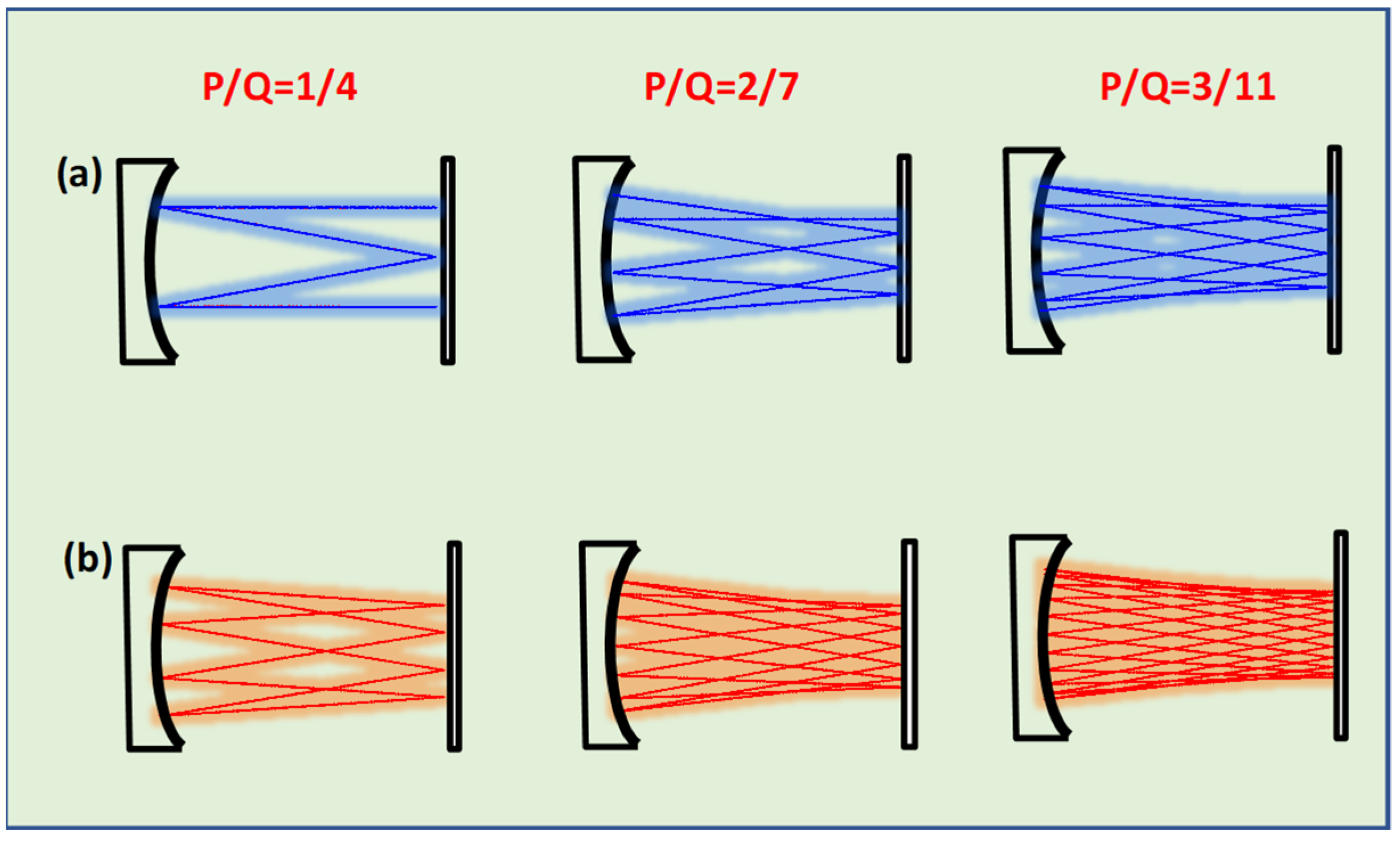




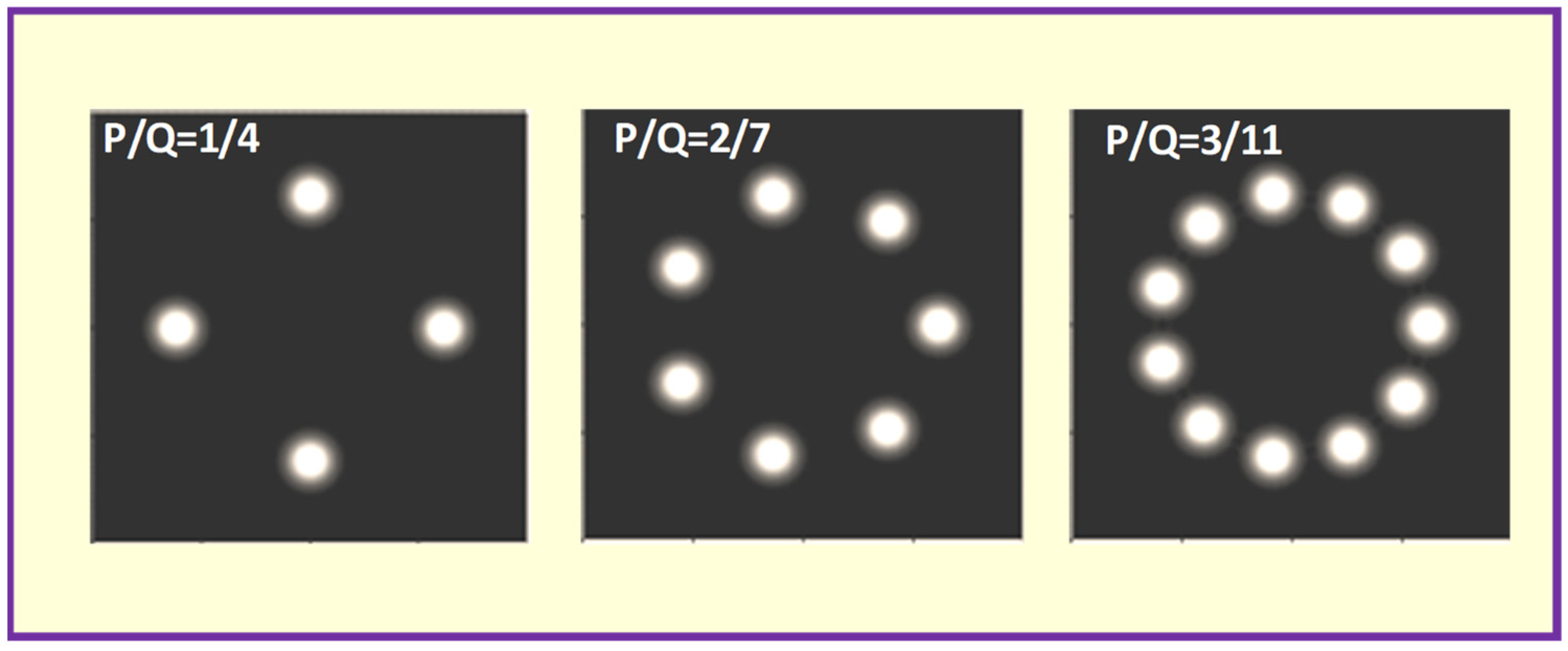

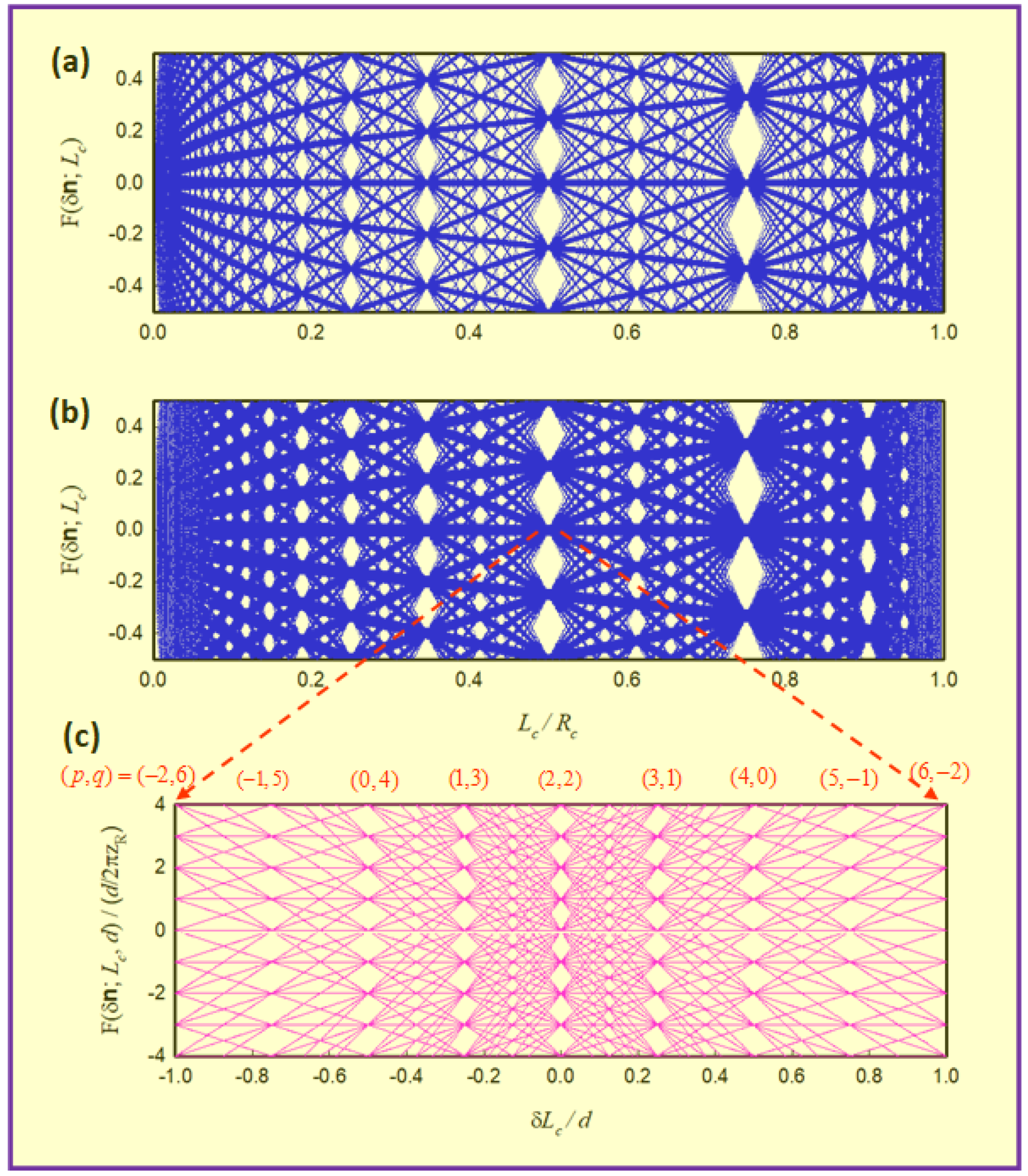
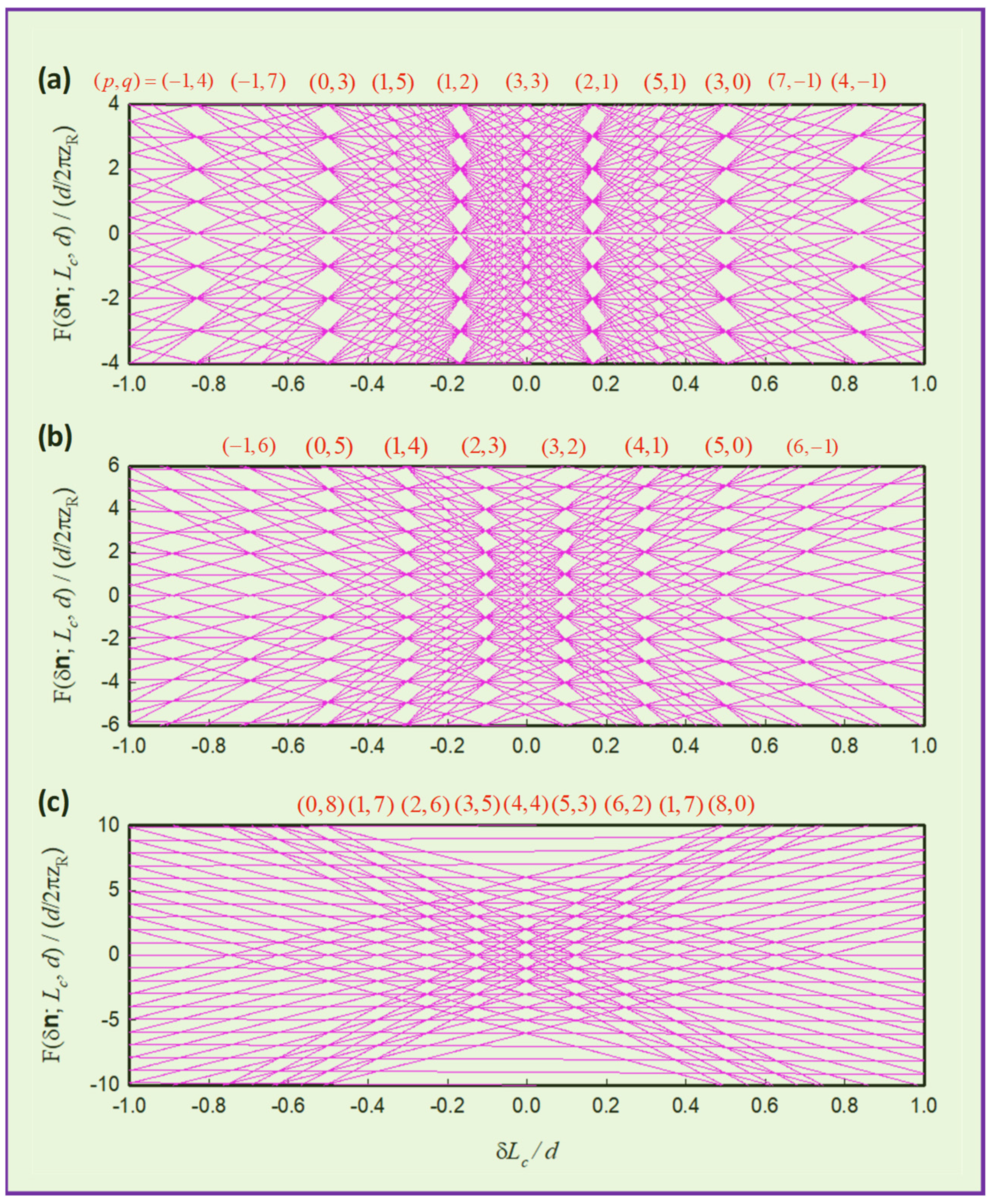

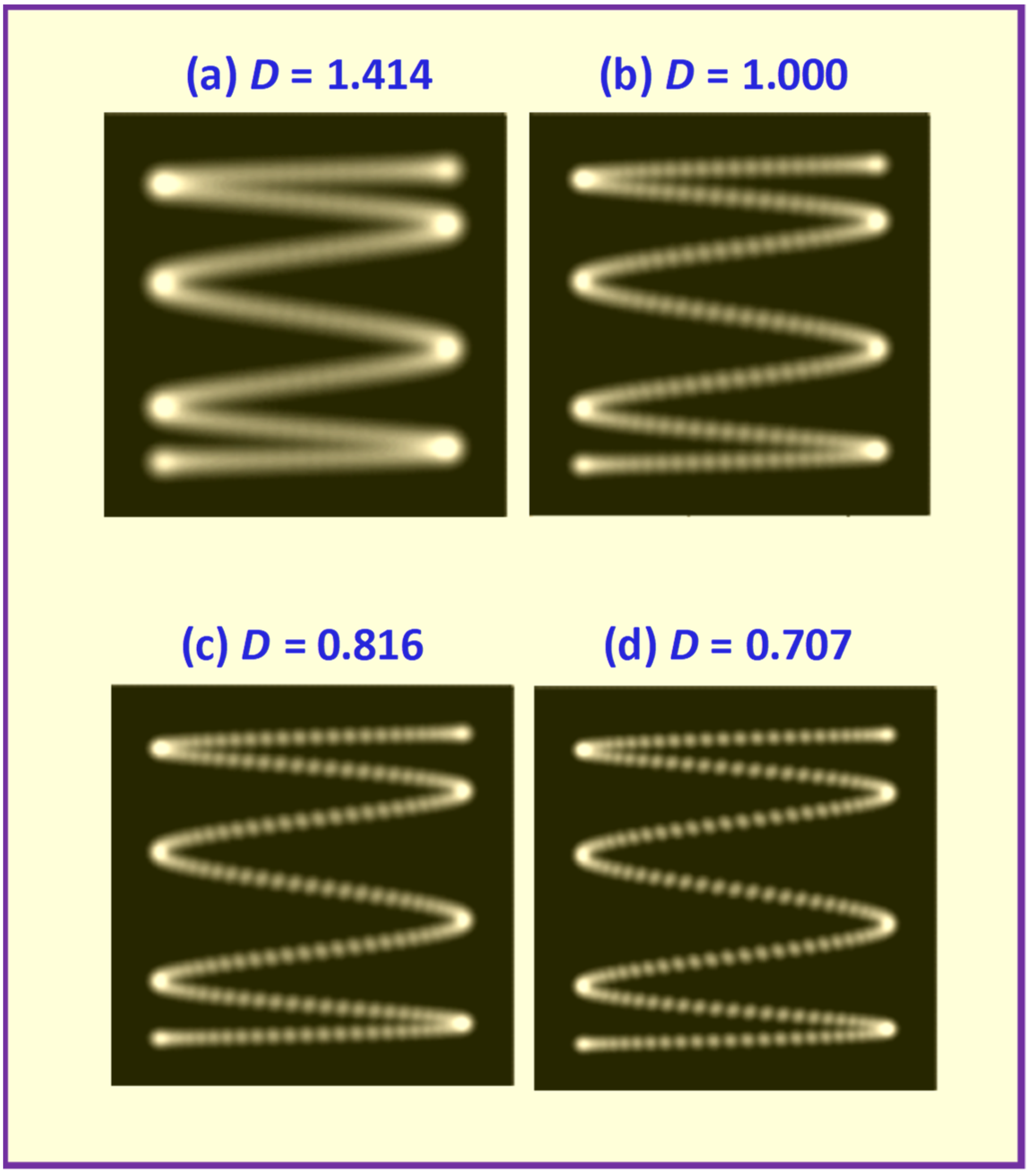
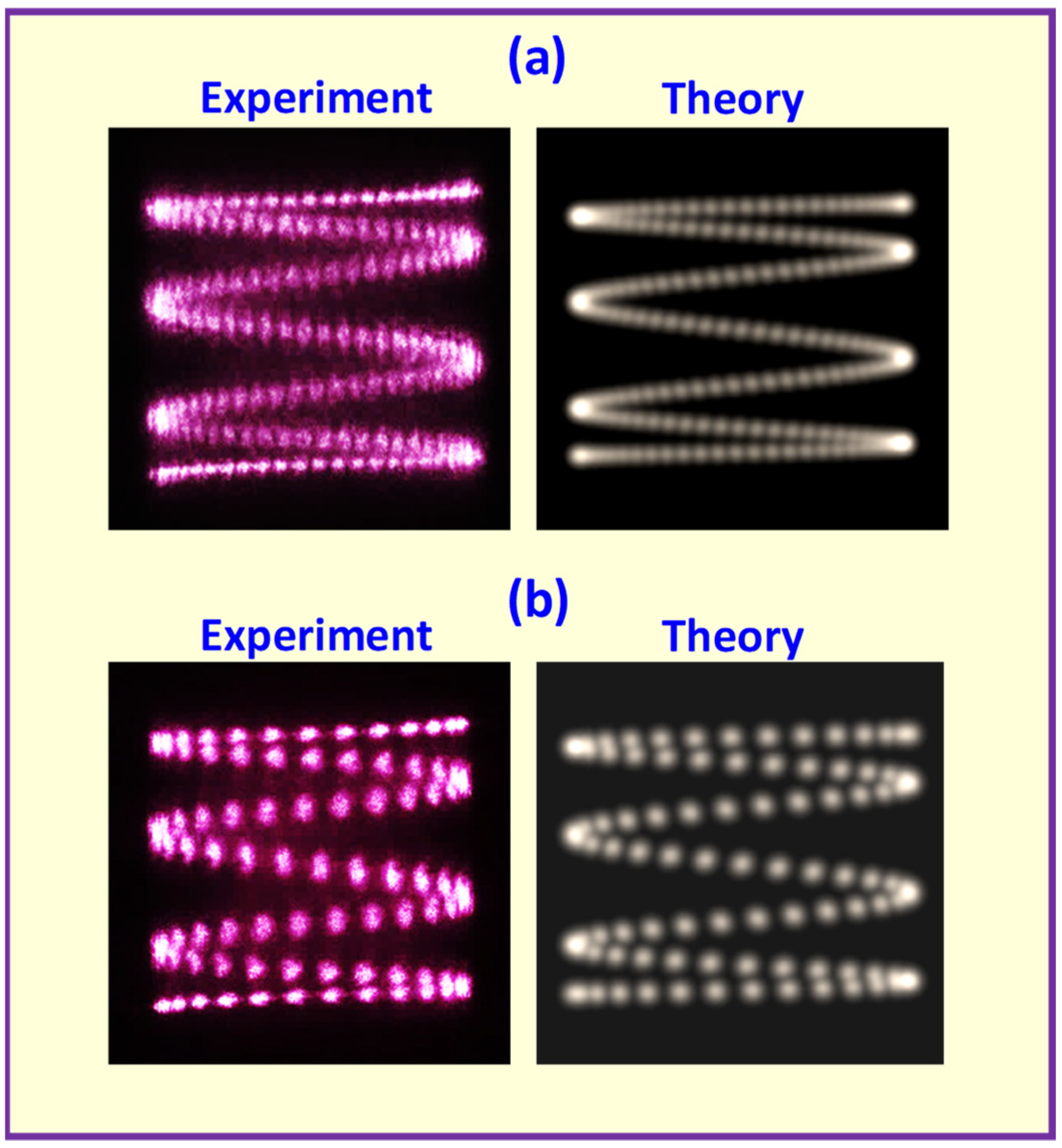
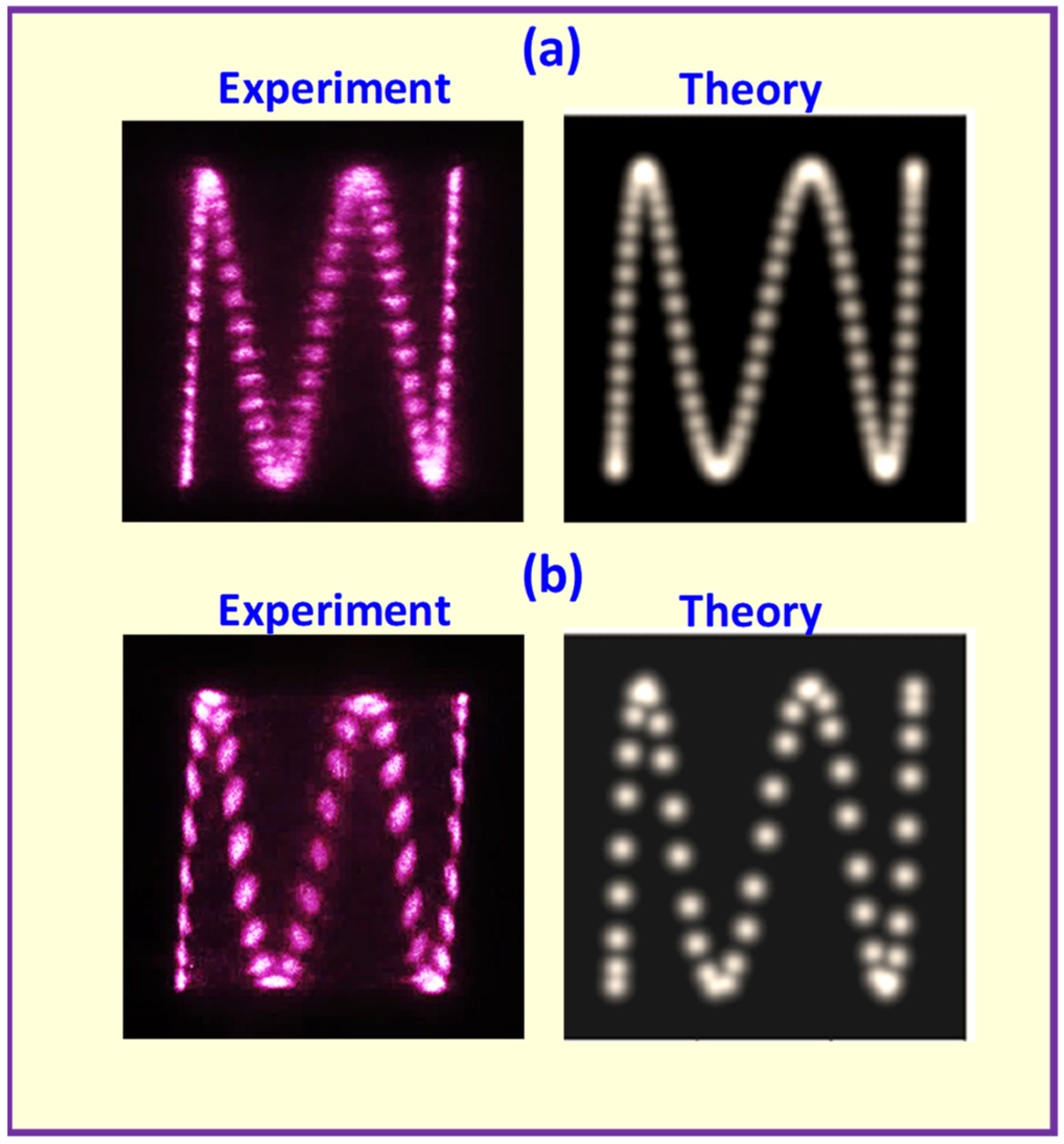
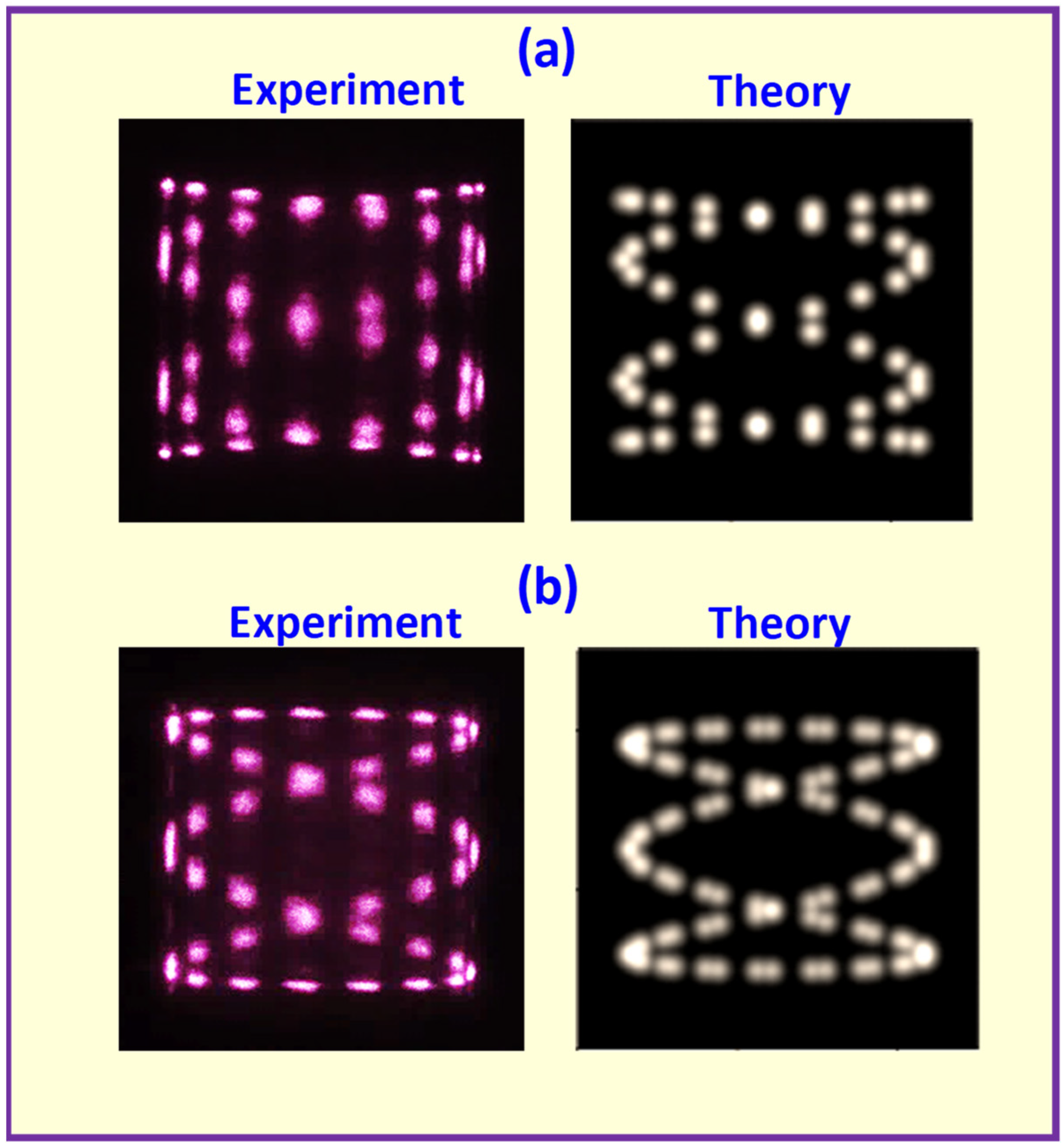

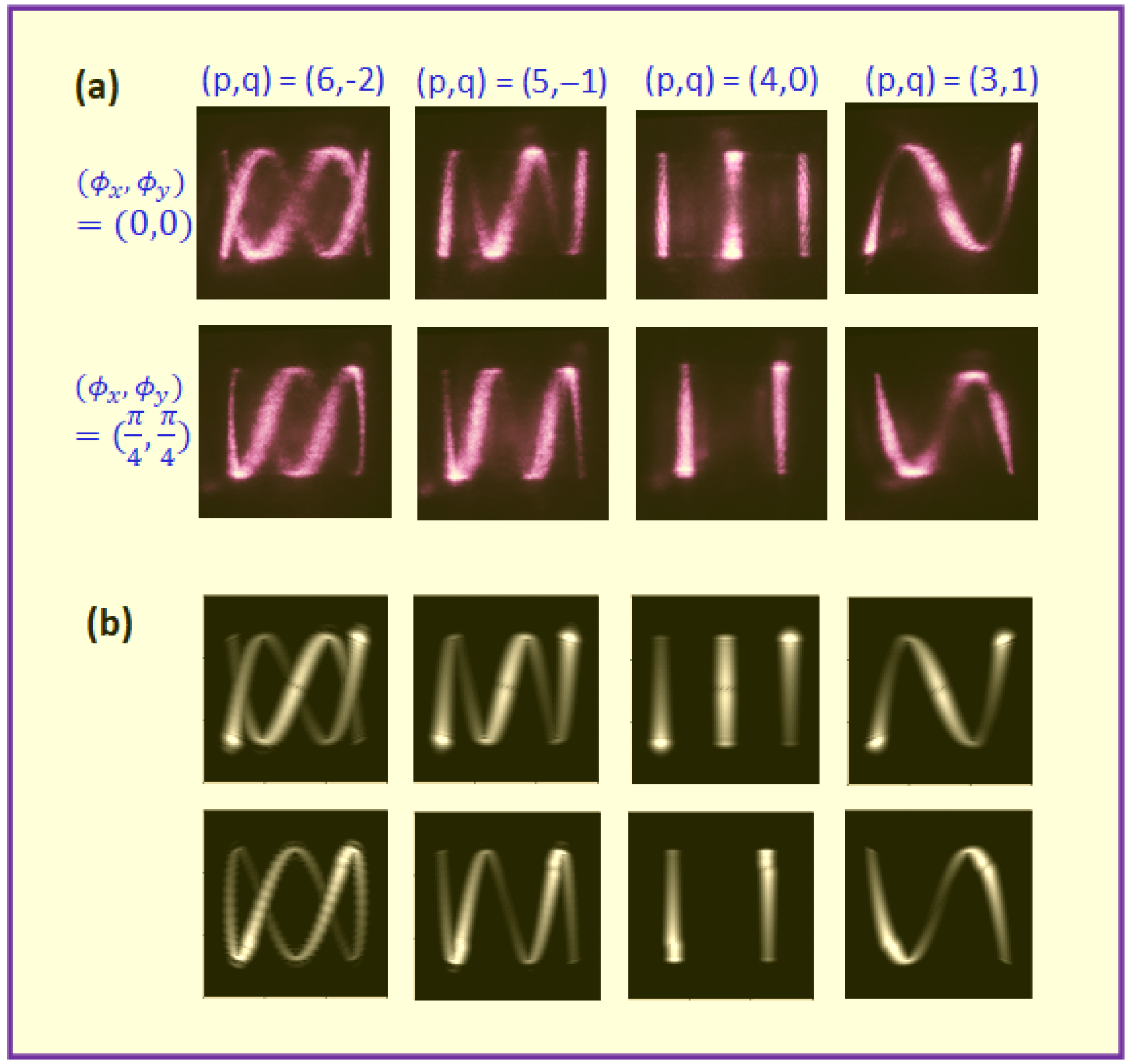

Publisher’s Note: MDPI stays neutral with regard to jurisdictional claims in published maps and institutional affiliations. |
© 2021 by the authors. Licensee MDPI, Basel, Switzerland. This article is an open access article distributed under the terms and conditions of the Creative Commons Attribution (CC BY) license (https://creativecommons.org/licenses/by/4.0/).
Share and Cite
Chen, Y.-F.; Wang, C.-H.; Zheng, X.-L.; Hsieh, M.-X. Laser Transverse Modes with Ray-Wave Duality: A Review. Appl. Sci. 2021, 11, 8913. https://doi.org/10.3390/app11198913
Chen Y-F, Wang C-H, Zheng X-L, Hsieh M-X. Laser Transverse Modes with Ray-Wave Duality: A Review. Applied Sciences. 2021; 11(19):8913. https://doi.org/10.3390/app11198913
Chicago/Turabian StyleChen, Yung-Fu, Ching-Hsuan Wang, Xin-Liang Zheng, and Min-Xiang Hsieh. 2021. "Laser Transverse Modes with Ray-Wave Duality: A Review" Applied Sciences 11, no. 19: 8913. https://doi.org/10.3390/app11198913





